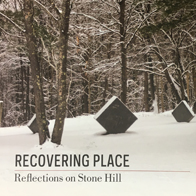
July 4–October 10, 2016
grafted trees
Grafted trees
Stone Hill Meadow
Early twenty-first century
Photo: Tucker Bair
TRANSCRIPT:
Over the course of my fifteen years of work as a landscape architect for the Clark, much of my team’s effort has focused on protecting the treasure we call Stone Hill. As the remnant of an open-pasture landscape that dominated the whole region a century ago, Stone Hill Meadow signifies the Clark’s deep involvement in the pastoral and likewise embodies its commitment to supporting the region’s cultural landscape. This venerable space marks a stark contrast with the regrowth forest that dominates the northern Berkshires, thereby honoring Williamstown’s agrarian past.
On one of my early visits to the Clark, I made a point of inspecting the groves of trees that stand out in the open field above the first crest of the hill as it slopes up and away from the reflecting pool—along the Pasture Trail where Thomas Schütte’s structure, Crystal, was sited in 2015. There I found an uncommon surprise: mature trees of three different species, physically joined and growing as one, grafted together by the accident of impossibly close proximity of their young stems in the open field. The paper birch, red maple, and white ash are important constituents of the eastern deciduous forest. Here they are, the sturdy worker trees, mysteriously sharing space and resources. Their conjoining neither benefits nor degrades their ecological function in the managed pastoral landscape. Wood fights wood for space, but there is no winner. The trees struggle along, intimately. I like to think of them as contingent hybrids: old coupled soldiers, icons of the forest cover, adventitiously growing and aging together in their odd and beautiful kinship, out there in the meadow.

Gary Hilderbrand is a landscape architect. He has led the planning and design of the Clark’s landscape renewal since 2001. He is a founding principal of Reed Hilderbrand, in Cambridge, Massachusetts, and is Professor in Practice at the Harvard Graduate School of Design. He has authored three books and two dozen essays on contemporary landscape architecture practice. He admits to a lifelong fascination with trees.
Recovering Place: Reflecting on Stone Hill
By Mark C. Taylor
An illustrated book chronicling the land art and sculptures created by Mark C. Taylor at his home in the Berkshire hills, echoing themes found in the exhibition. Supported in part by Herbert A. Allen, Jr. and the Clark Art Institute and published by Columbia University Press. Call the Museum Store at 413 458 0520 to order.

